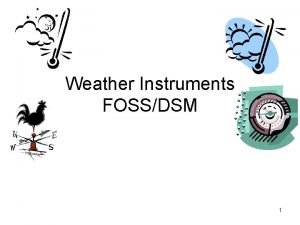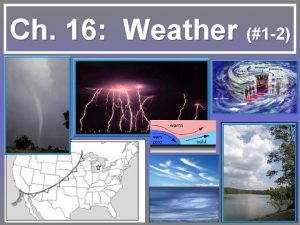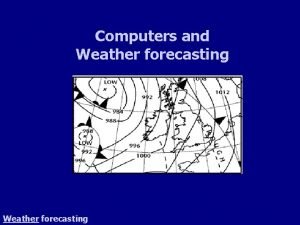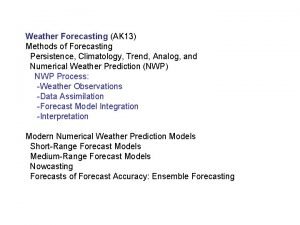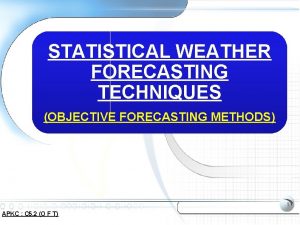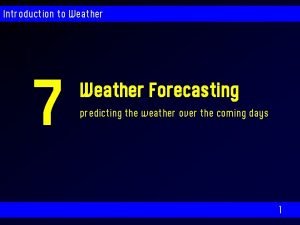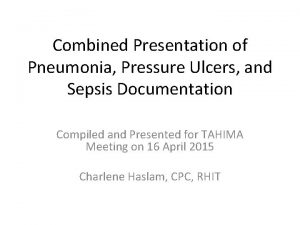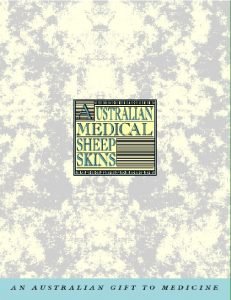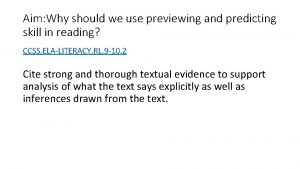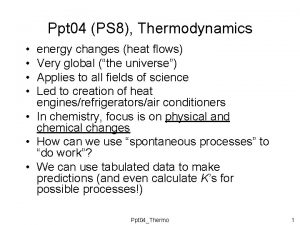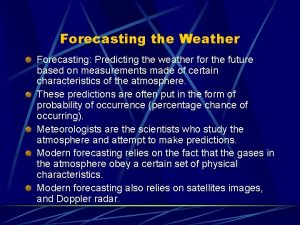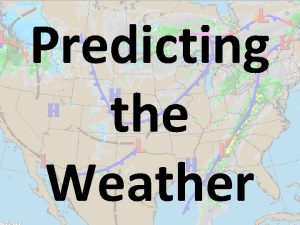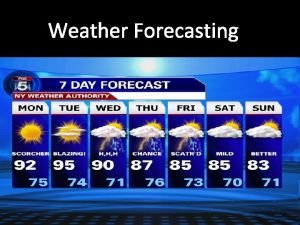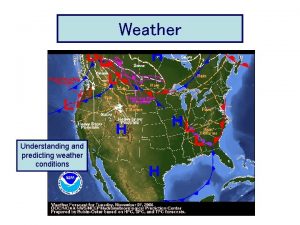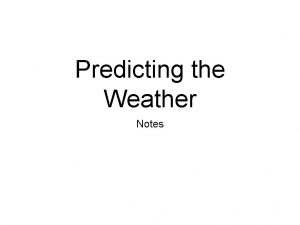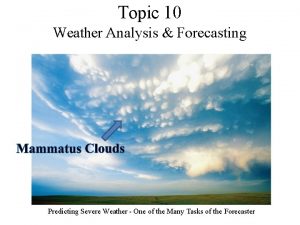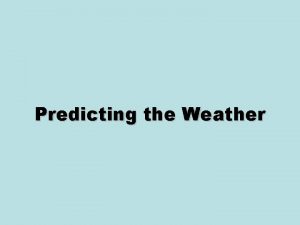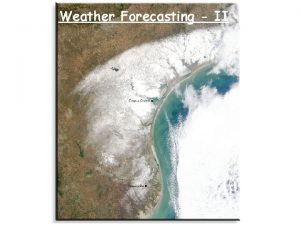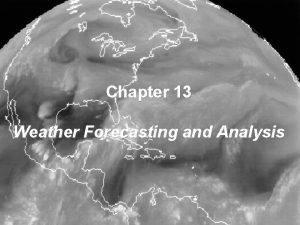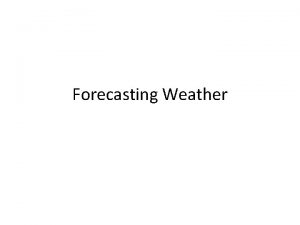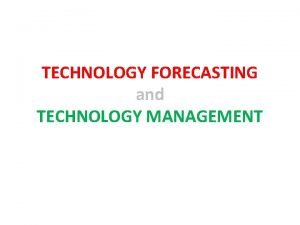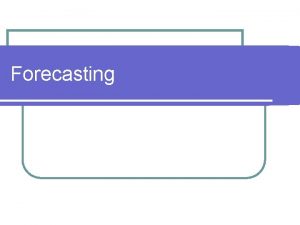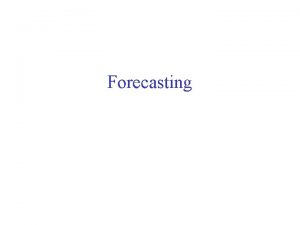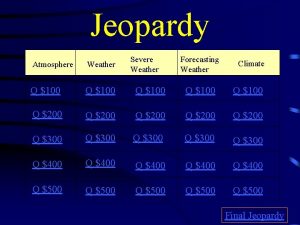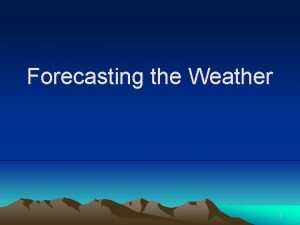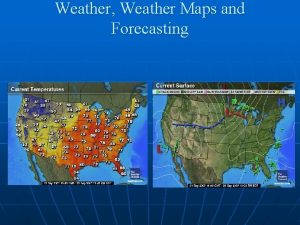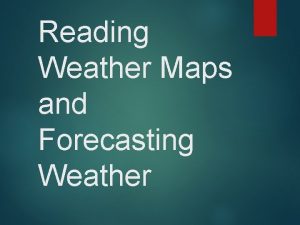Weather Forecasting 2009 Predicting the weather People have























- Slides: 23

Weather Forecasting 2009

Predicting the weather • People have needed to predict the weather since the dawn of time. • Hunting, farming, and all outdoor work depends on the weather. • Folklore grew around the observations people made. A ring around the sun or moon, means that rain will come real soon. Red sky at night, sailor's delight; red sky in the morning, sailor's take warning.

Modern Forecasting • Relies on: • Observation using various instruments • Computer models • Previous trends and patterns in the weather. • Can be accurate up to five days in the future.

Trends and Patterns • Meteorologists: Scientists that study the causes of weather and try to predict it. • They use data collected over the past 100 or more years to make their predictions. • So when they say “There is a 40% chance of rain today, ” they mean that in the past, when the conditions were similar, it rained 40% of the time.

Weather Instruments • A thermometer measures temperature. A barometer measures air pressure. A rain gauge measures precipitation. An anemometer measures wind speed. • Weather vanes find wind direction. • A psychrometer measures relative humidity.

Weather Technology • New technologies have made short range (2 to 5 days or so) forecasting fairly reliable. • They are now working on long range predictions. • Changes in technology are making this possible: • Satellites and computers.

Computer Models • Computers can take millions of pieces of data and process this information to make predictions. • Predictions are only as good as the computer model.

Weather Radar • Uses Doppler radar to track moving storms and precipitation. • NEXRAD is the new generation Doppler radar that tracks wind and precipitation. • This allows tornadoes to be accurately tracked.

Weather Balloons • Weather balloons carry equipment up to 30 kms high • A radiosonde attached to a weather balloon measures weather high in the atmosphere. • This equipment records data and sends it to weather stations

Weather Satellites • A lot of data comes from satellites • They take pictures of the earth from outer space. • They can also collect data on temperature, cloud height, and moisture. • Then the satellites send their data to weather stations

Weather Maps • There are many different kinds of weather maps. • Data from local weather stations from all over the country is collected to create national weather maps.

Temperature Map • Shows the current temperatures.

Radar Maps • Shows precipitation.

National Wind Map • Shows wind speed and direction.

Infrared Satellite • Shows cloud top temperature.

Fronts

Visible Satellite • Shows picture from space.

Precipitation • Shows precipitation in inches.

Humidity • Shows the relative humidity.

Isobars • Show areas of equal pressure. • Inner most circles will be the low or high pressure areas.

Isotherms • Lines show areas of equal temperature. • Isotherm maps show where temperatures are relatively high and low, and also where temperature changes are gradual or dramatic over a distance.

NWSChapter and 16 Maps Weather Maps • The National Weather Service produces weather maps based on information gathered from about 1, 000 weather stations across the United States.

Weather Map Symbols • These are the symbols you would see on a weather map. • The arrows or bumps point in the direction the front is moving.
 What does a wind vane measure
What does a wind vane measure Ch 16 weather
Ch 16 weather Computer in weather forecasting
Computer in weather forecasting Persistence weather forecasting
Persistence weather forecasting Statistical forecasting techniques
Statistical forecasting techniques Introduction to weather forecasting
Introduction to weather forecasting What happens when the temperature of the air cools brainpop
What happens when the temperature of the air cools brainpop Prism with 12 faces
Prism with 12 faces Predicting products of chemical reactions
Predicting products of chemical reactions Predicting products of chemical reactions
Predicting products of chemical reactions More predicting products of chemical reactions
More predicting products of chemical reactions Predicting good probabilities with supervised learning
Predicting good probabilities with supervised learning Combination reaction equation
Combination reaction equation Braden scale for predicting pressure sore risk
Braden scale for predicting pressure sore risk Bahasa inggris disusun oleh
Bahasa inggris disusun oleh Braden scale for predicting pressure sore risk
Braden scale for predicting pressure sore risk What is previewing
What is previewing Predicting pip
Predicting pip Predicting pip
Predicting pip Formula of vsepr theory
Formula of vsepr theory Predicting single replacement reactions
Predicting single replacement reactions Predicting spontaneity
Predicting spontaneity Predicting spontaneity
Predicting spontaneity Ten ways to untwist your thinking
Ten ways to untwist your thinking
